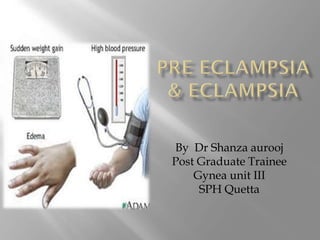This document discusses the diagnosis and management of hypertensive disorders in pregnancy. It defines various types of hypertension including gestational hypertension, preeclampsia, and eclampsia. It covers the signs and symptoms, potential complications, risk factors, diagnostic tests, and treatment approaches including antihypertensive medications and magnesium sulfate administration. Treatment involves controlling blood pressure, preventing seizures, administering steroids to promote fetal lung maturity, and carefully monitoring fluid balance, with the goal of optimizing outcomes for both the mother and baby.





























![ Use the Collaborative Eclampsia Trial[2]
regimen for administration of magnesium
sulphate*:
loading dose of 4 g should be given
intravenously over 5 minutes, followed by an
infusion of 1 g/hour maintained for 24 hours
recurrent seizures should be treated with a
further dose of 2–4 g given over 5 minutes.
Do not use diazepam, phenytoin as an
alternative to magnesium sulphate* in women
with eclampsia.
(NICE GUIDELINE)](https://image.slidesharecdn.com/preeclampsiaeclampsia-140428082859-phpapp01/85/Pre-eclampsia-eclampsia-30-320.jpg)






















